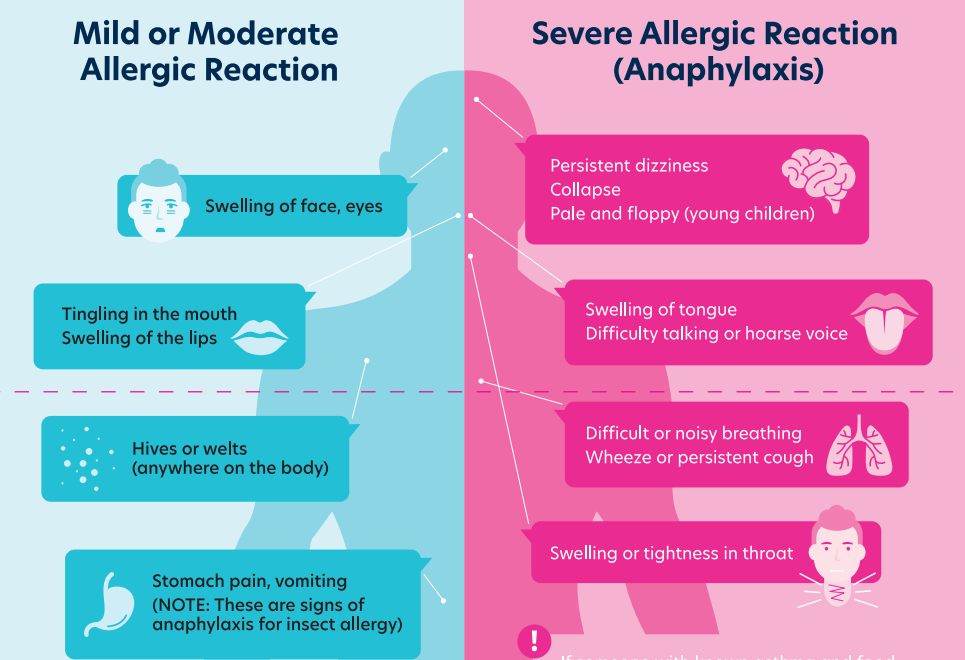Updated April 2025
On this page

People with cow’s milk (dairy) allergy are allergic to the protein in milk. Milk allergy is one of the most common food allergies in childhood, affecting more than 2% of babies in Australia. Milk allergy is one of the more difficult food allergies to manage because milk is found in many foods and is hard to avoid.
The following information on this page refers to IgE mediated cow’s milk allergy.
Information on non-IgE-mediated (delayed) cow’s milk allergy, also known as cow’s milk protein intolerance, can be found on the Non-IgE-mediated food allergy webpage.
In the past, most children would outgrow their milk allergy before starting school, but increasing numbers now outgrow their milk allergy much later, and milk allergy can remain for life.
There is no cure for food allergy. Currently, there are different ways to manage food allergy. Most people with milk allergy must avoid foods which are made from milk although some people may be able to eat small amounts of milk which is baked, such as in muffins, cakes or biscuits.
Oral Immunotherapy (OIT) may also be an option for some people with milk allergy. OIT is a special treatment program sometimes offered and supervised by allergy specialists. Speak with your allergy specialist about whether baked milk or OIT may be an option.
For more information see Food Allergy management and treatment.
Food Alerts to your inbox
What are the signs and symptoms of an allergic reaction to food?
Signs and symptoms of a food allergy usually occur soon after eating the food or within two hours of eating. Allergic reactions to food can be mild, moderate or severe (anaphylaxis).
An allergic reaction may start with mild or moderate signs or symptoms but can progress rapidly to anaphylaxis. However, it is important to remember that signs of a mild or moderate allergic reaction may not always occur before anaphylaxis.
Signs and symptoms of an allergic reaction
Learn about the signs and symptoms of allergic reactions, and the difference between a mild or moderate reaction and a severe reaction (anaphylaxis).

If a person has a cow’s milk allergy, another source of calcium, energy and protein is required for good nutrition and growth. Speak to your doctor or allergy dietitian for advice.
What foods and products contain milk?
In Australia and New Zealand, the food law (Food Standards Code) requires the mandatory declaration of the common allergy causing foods. As milk is a common allergen, milk must be written in bold in the ingredient list on packaged food if it is an ingredient. See our food labelling page for further information.
Food and drinks to avoid if you have a milk allergy include:
- Cow’s milk and baby formula made from cow’s milk
- Other dairy products such as:
- Yoghurt
- Cheese
- Cream
- Ice cream
- Butter
- Ghee
Most people with cow’s milk allergy also have an allergy to milk and formula made from other animals such as goat, camel and sheep, as the proteins causing the allergic reaction are very similar.
Milk can be found in many foods and as an ingredient in many products such as baked goods, sauces, processed meats and confectionery. Download our milk food allergen card to your phone or print and place on your refrigerator at home. This allergen card contains examples of the foods and products that may contain milk.
Check for milk “hidden” in foods and drinks: For example
- Salami and other processed meats
- Protein shakes
- Mashed potato
- Potato crisps
A note about vegan products: People with a milk allergy should always check the ingredient list and any allergen statements on products labelled ‘’vegan’’ and not assume that they are safe. Vegan products do not have to be ‘milk free’ and may contain milk through cross contamination. Go to our vegan page for more information.
A note about dark chocolate: Due to manufacturing processes, dark chocolate can contain milk even though milk has not been added as an ingredient. Please do not assume dark chocolate is safe for people with milk allergy. Go to our dark chocolate page for more information.
A note about mouth care products: Dental and mouthcare products, such as medicated toothpaste and chewing gum may contain milk. Sometimes milk in these products is listed by other names, such as casein, Casein-Phosphopeptide (CPP), Recaldent™, or CPP-ACP. Go to our anaphylaxis and your teeth page for more information.
REMEMBER: You cannot tell what ingredients foods contain by looking at them, smelling them or tasting them. ALWAYS read labels when eating packaged food and when eating out, ALWAYS tell people preparing and serving food you have a food allergy. ASK about food content after you have told them about your food allergy.
To make eating out a little easier, A&AA has developed a chef card. You can write or print your allergens on the card. When telling the wait staff at a cafe or restaurant about your allergies, hand over your chef card and ask it to come back with your specially prepared meal.
Milk allergy is different to lactose intolerance
Cow’s milk allergy is different to lactose intolerance. People with milk allergy are allergic to the protein in milk and can react with a mild/moderate or a severe allergic reaction (anaphylaxis).
People with lactose intolerance feel unwell when they have dairy products with lactose because they cannot digest the lactose, which is a type of sugar. Lactose intolerance does not cause a life-threatening allergic reaction.
People with milk allergy CANNOT eat dairy products that are lactose free. Lactose free products do not contain lactose (a type of sugar) but still contain cow’s milk protein.
Downloads
More about food allergies
Food allergy
Learn more about different food allergies, triggers, signs and symptoms and more.
Living with allergies
Learn more about living with allergies, daily management, what to do in an emergency and more.
